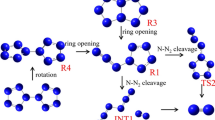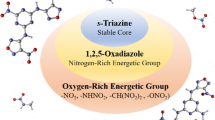Abstract
To develop high-energetic stability nitroform compounds, three types of nitroform derivatives based on hexanitroethane structure are designed. The guidelines for selecting these compounds are based on (1) constructing a flexible molecule and weakening the external force by elastic deformation and (2) forming negative ion or introducing electron-rich group to eliminate the electron-deficient situation. The conformations and some important properties of them are calculated at B3LYP/6-311 + G(d) level. Based on the bond order and bond dissociation enthalpy analysis, C–NO2 bond is considered to be the most unstable position, and both of the methods can improve the stability of designed compounds. Based on molecular energy gap (HOMO-LUMO) and density of state (DOS) analysis, it is found that introducing of bridge atoms is helpful to lower the sensitivity, while the construction of anions changes both HOMO-LUMO and DOS which shows obvious ionic properties. A further study on the electrical potential surface shows that the probability for extreme values of designed compounds decreases which is beneficial for high stability. Finally, the explosive properties and impact sensitivity of them are calculated. Results show that their explosive performances are obviously better than current energetic oxidants and some of them maintain low sensitivity.






Similar content being viewed by others
References
Vo TT, Parrish DA, Shreeve JM (2014) Tetranitroacetimidic acid: a high oxygen oxidizer and potential replacement for ammonium perchlorate. J Am Chem Soc 136:11934–11937
Ding P, Wang H, Wen L, Cheng G, Lu C, Yang H (2014) Studies on synthetic technology and reduced sensitivity technology of hydrazinium nitroformate. Ind Eng Chem Res 53:13851–13855
Belanger-Chabot G, Rahm M, Haiges R, Christe KO (2013) BH3C(NO2) (3) (−): the first room-temperature stable (trinitromethyl)borate. Angew Chem Int Ed 52:11002–11006
Zhang Q, Zhang J, Parrish DA, Shreeve JM (2013) Energetic N-trinitroethyl-substituted mono-, di-, and triaminotetrazoles. Chem-eur J 19:11000–11006
Bartashevich EV, Pendas AM, Tsirelson VG (2014) An anatomy of intramolecular atomic interactions in halogen-substituted trinitromethanes. Phys Chem Chem Phys 16:16780–16789
Volkova YA, Averina EB, Grishin YK, Bruheim P, Kuznetsova TS, Zefirov NS (2010) Unexpected heterocyclization of electrophilic alkenes by tetranitromethane in the presence of triethylamine. Synthesis of 3-Nitroisoxazoles. J Organomet Chem 75:3047–3052
Fedorov AV, Mikhaylov AL, Men'Shikh AV, Nazarov DV, Finyushin SA, Davydov VA (2010) On the stability of the detonation wave front in the high explosive liquid mixture tetranitromethane/nitrobenzene. J Energ Mater 28:205–215
Bougeard D, Boese R, Polk M, Woost B, Schrader B (1986) Crystallographic and vibrational study of hexanitroethane. J Phys Chem Solids 47:1129–1137
Golod EL, Bagal LI (1994) Destructive nitration of polynitrocarbonyl compounds – new technique for the preparation of hexanitroethane. Zh Org Khim 30:29–32
Klapoetke TM, Schmid PC, Schnell S, Stierstorfer J (2015) Thermal stabilization of energetic materials by the aromatic nitrogen-rich 4,4 ',5,5 '-tetraamino-3,3 '-bi-1,2,4-triazolium cation. J Mater Chem A 3:2658–2668
Klapoetke TM, Krumm B, Moll R, Rest SF, Vishnevskiy YV, Reuter C, Stammler H-G, Mitzel NW (2014) Halogenotrinitromethanes: a combined study in the crystalline and gaseous phase and using quantum chemical methods. Chem-eur J 20:12962–12973
Jadhav PM, Radhakrishnan S, Ghule VD, Pandey RK (2015) Energetic salts from nitroformate ion. J Mol Model 21:134
Joo Y-H, Min BS (2014) Denitration of hydrazinium nitroformate to form hydrazinium dinitromethanide. New J Chem 38:50–54
Ball DW (2012) Structure and thermodynamic properties of nitroformic acid, nitroformyl nitrate, and ammonium nitroformate. Struct Chem 23:693–701
Fischer D, Klapotke TM, Stierstorfer J (2016) Tetranitratoethane. Chem Commun 52:916–918
Huang Y, Gao H, Twamley B, Shreeve JM (2007) Synthesis and characterization of new energetic nitroformate salts. Eur J Inorg Chem 2025-2030
Yin P, Zhang Q, Shreeve JM (2016) Dancing with energetic nitrogen atoms: versatile N-functionalization strategies for N-heterocyclic frameworks in high energy density materials. Acc Chem Res 49(1):4–16
Becke AD (1993) Density-functional thermochemistry. III. The role of exact exchange. J Chem Phys 98:5648–5652
Becke AD (1992) Density functional thermochemistry. II. The effect of the Perdew-Wang generalized gradient correlation correction. J Chem Phys 97:9173–9177
Perdew JP (1991) In: Ziesche P, Eschrig H (eds) Electronic structure of solids ’91. Akademie, Berlin
Perdew JP, Chevary JA, Vosko SH, Jackson KA, Pederson MR, Singh DJ, Fiolhais C (1992) Atoms, molecules, solids, and surfaces: applications of the generalized gradient approximation for exchange and correlation. Phys Rev B 46:6671–6687
Frisch MJ, Trucks GW, Schlegel HB, Scuseria GE, Robb MA, Cheeseman JR, Montgomery JA Jr, Vreven T, Kudin KN, Burant JC, Millam JM, Iyengar SS, Tomasi J, Barone V, Mennucci B, Cossi M, Scalmani G, Rega N, Petersson GA, Nakatsuji H, Hada M, Ehara M, Toyota K, Fukuda R, Hasegawa J, Ishida M, Nakajima T, Honda Y, Kitao O, Nakai H, Klene M, Li X, Knox JE, Hratchian HP, Cross JB, Bakken V, Adamo C, Jaramillo J, Gomperts R, Stratmann RE, Yazyev O, Austin AJ, Cammi R, Pomelli C, Ochterski JW, Ayala PY, Morokuma K, Voth GA, Salvador P, Dannenberg JJ, Zakrzewski VG, Dapprich S, Daniels AD, Strain MC, Farkas O, Malick DK, Rabuck AD, Raghavachari K, Foresman JB, Ortiz JV, Cui Q, Baboul AG, Clifford S, Cioslowski J, Stefanov BB, Liu G, Iiskorz P, Komaromi I, Martin RL, Fox DJ, Keith T, Al-Laham MA, Peng CY, Nanayakkara A, Challacombe M, Gill PMW, Johnson B, Chen W, Wong MW, Gonzalez C, Pople JA (2004) Gaussian 03 (Revision C.01); Gaussian, Inc, Wallingford, CT
Blanksby SJ, Ellison GB (2003) Bond dissociation energies of organic molecules. Acc Chem Res 36:255–263
Yao XQ, Hou XJ, Jiao H, Xiang HW, Li YW (2003) Accurate calculations of bond dissociation enthalpies with density functional methods. J Phys Chem A 107:9991–9996
Stewart JJP (1989) Optimization of parameters for semiempirical methods I. Method. J Comput Chem 10:209–220
Kamlet MJ, Jacobs ST (1968) Chemistry of detonations. I. A simple method for calculating detonation properties of CHNO explosives. J Chem Phys 48:23–35
Politzer P, Martinez J, Murray JS, Concha MC, Toro-Labbé A (2009) An electrostatic interaction correction for improved crystal density prediction. Mol Phys 107:2095–2101
Keshavarz MH, Soury H, Motamedoshariati H, Dashtizadeh A (2015) Improved method for prediction of density of energetic compounds using their molecular structure. Struct Chem 26:455–466
Lu T, Chen F (2012) Multiwfn: a multifunctional wavefunction analyzer. J Comput Chem 33:580–592
Rice BM, Hare JJ, Byrd EFC (2007) Accurate predictions of crystal densities using quantum mechanical molecular volumes. J Phys Chem A 111:10874–10879
Pospíšil M, Vávra P, Concha M, Murray J, Politzer P (2010) A possible crystal volume factor in the impact sensitivities of some energetic compounds. J Mol Model 16:895–901
Qiu L, Xiao HM, Gong XD, Ju XH, Zhu WH (2006) Theoretical studies on the structures, thermodynamic properties, detonation properties, and pyrolysis mechanisms of spiro nitramines. J Phys Chem A 110:3797–3807
Li QH, Wang PC, Lu M (2015) The importance of molecular conformation to the properties: a DFT study of the polynitro heterocyclic compounds based on dodecahydrodiimidazo [4,5-b:4′,5′-e] pyrazine structure. Struct Chem 26:667–674
Xu XJ, Xiao HM, Gong XD, Ju XH, Chen ZX (2005) Theoretical studies on the vibrational spectra, thermodynamic properties, detonation properties, and pyrolysis mechanisms for polynitroadamantanes. J Phys Chem A 109:11268–11274
Atkins PW (1982) Physical chemistry. Oxford University Press, Oxford
Politzer P, Murray JS, Brinck T (1994) Lane PImmunoanalysis of agrochemicals, ACS Sympsium series 586. American Chemical Society, Washington, DC
Murray JS (1994) Politzer P in quantitative treatment of solute/solvent interactions, theoretical and computational chemistry. Elsevier, Amsterdam
Son SF, Brewster MQ (1993) Unsteady combustion of solid propellants subject to dynamic external radiant heating. Combust Explos Shock Waves 29:281–285
Wang PC, Zhu Z, Xu J, Zhao X, Lu M (2013) Theoretical study of the thermodynamic and burning properties of oxygen-rich hydrazine derivatives-green and powerful oxidants for energetic materials. J Mol Model 19:2583–2591
Mayer I (2007) Bond order and valence indices: a personal account. J Comput Chem 28:204–221
Lu T, Chen F (2013) Bond order analysis based on the Laplacian of electron density in fuzzy overlap space. J Phys Chem A 117:3100–3108
Lu T, Chen F (2012) Quantitative analysis of molecular surface based on improved Marching Tetrahedra algorithm. J Mol Graph Model 38:314–323
Rice BM, Hare JJ (2002) A quantum mechanical investigation of the relation between impact sensitivity and the charge distribution in energetic molecules. J Phys Chem A 106:1770–1783
Author information
Authors and Affiliations
Corresponding author
Additional information
Publisher’s note
Springer Nature remains neutral with regard to jurisdictional claims in published maps and institutional affiliations.
Electronic supplementary material
ESM 1
(DOC 39 kb)
Rights and permissions
About this article
Cite this article
He, Y., Zhang, H. & Lv, M. The strategy for improving the stability of nitroform derivatives—high-energetic oxidant based on hexanitroethane. J Mol Model 26, 181 (2020). https://doi.org/10.1007/s00894-020-04451-z
Received:
Accepted:
Published:
DOI: https://doi.org/10.1007/s00894-020-04451-z




